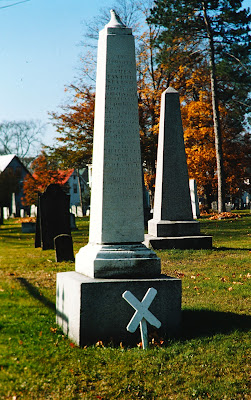 |
James’ three sons, James, William, and John F., formally entered into a partnership with their father in 1821, forming “James Taylor Senior and Company”. In addition to their store, the Taylors operated a mill and shipyard on the western end of Fredericton. They also owned a mill on the Nashwaak (present-day Marysville) that eventually sold to Alexander "Boss" Gibson.
As a leading building firm, their company was chosen in 1826 to construct the Kings College building (present-day Old Arts Building, University of New Brunswick). For this project they arranged the arrival of stone masons from Scotland in 1826. Their company also built Fredericton’s first Market and Court House, located on the site of the present-day former York County Court House (649 Queen Street).
As the inscription on the Taylor family stone will attest, James Taylor was “a public spirited man;” and as Judge Oswald S. Crockett observed in 1923:
There was no family which was more closely or prominently identified with the Fredericton Society of Saint Andrew during the first quarter century of its history than that of James Taylor snr.
 |
| Willam Taylor - Collection of Library & Archives Canada, MIKAN 2894969 |
James senior was instrumental in successfully bringing 134 Scottish settler to New Brunswick, chartering the Saint John vessel The Favourite in 1816; he donated the land on which Fredericton’s first Market Building was established (649 Queen Street), as well as the land where the first St Paul’s church was built (500 George Street). His sons, William and James jnr were members of the building committee for the original St Paul’s Church, and the actual church design was conceived by William Taylor. John F. Taylor was one of the founding members of the Fredericton Curling Club.
The Taylor home was located on the east end of King Street (present-day 780 King Street)—where they lived as fellow neighbours to Society members Robert Thorburn, Robert Gowan, and John Simpson.
It was for the burial of James senior in 1834—the oldest founding member of the Society—that the Society enacted their funeral traditions of honouring deceased members. As was stated in the minutes of a special meeting held in the home of John Gregory on December 26 1834:
… that the members of the Society do attend in a body at the funeral of the much respected deceased member and that they do walk in procession in front of the hearse in the following order:
Members two and two.
The Secretary
(John Gregory)
President and Vice President
President and Vice President
(John Simpson and Robert Gowan)
Chaplains
Chaplains
(Rev. Dr Somerville and Rev James Birkmyre)
And that at the graveyard the Society form a line on each side of the road, and, allowing the body to pass, fall in the rear of the chief mourners
It was also resolved:
…that it is expected that every member will attend half an hour before the time fixed for the funeral dressed in black with weeper’s crepe and Blue Guards… and that the body be lowered into the grave b y the President, Vie President, and the four members who may bear the body.
Thus was laid to rest the oldest founding member of the Society.
John F. Taylor became a very close and personal friend of Robert Fulton. The two never married, and as Judge O S Crocket later recalled: “…there was never a week that the two did not spend two or three evenings together in the apartments of one or the other.”
Such was their bond that upon John Taylor’s passing in 1858, Robert anonymously commissioned the Taylor family stone. The inscription speaks clearly of his love and admiration for the John F. Taylor and the Taylor family:
In
memory
of James
Taylor
Sen. Esq
Merchant
a native of
Scotland
and a public
spirited man
who spent the
most of his years
in Fredericton
and who died here on
Dec 26 1834
aged 78 years
Also
his sons
his eldest
William , M.P.P.
died
March 27 1834
James. M.P.P.
died
Feb 4th 1856
John F
Merchant
my particular friend
died Oct 19 1858
aged 61 years
This monument
is erected by a Scotsman
from his first acquaintance
with the family in 1822
never ceased to admire and appreciate
their probity of character
their friendliness and
general goodness of heart
Benefactors to the Community in which they lived
In memory of
Thomas Taylor
born in Port Glasgow
Scotland
Died at Fredericton Dec 8th 1843
aged 56 years
The memory of the just is blessed

Comments
Post a Comment